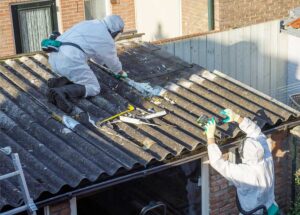A Homeowner’s Guide to Recognizing & Getting Rid of Asbestos
Before people learned about its health risks, asbestos, a mineral known for being resistant to fire and long-lasting, was used a lot in buildings. When disturbed, its minuscule strands have the potential to become airborne and pose serious health risks. Householders must comprehend the characteristics of asbestos and be able to locate possible exposure sources.

Understanding Asbestos: A Hazard in Homes
Six naturally occurring minerals together are referred to as asbestos, and they have been extracted and utilized for business purposes for hundreds of years. It was widely used in a variety of building materials due to its insulating and heat-resistant qualities. Nevertheless, asbestos’s use in building materials had drastically declined by the 1980s because of its association with serious health problems such as mesothelioma and lung cancer. Asbestos-based materials are still permitted in older homes even if they are prohibited in new construction.
In addition to roofing materials, cement products, textured paints, insulation, and vinyl floor tiles are popular places to find asbestos. As these materials break down, tiny asbestos fibers are released into the air and pose a risk to human health if ingested.
Identifying Asbestos in Your Home
Materials containing asbestos can be difficult to identify because they frequently resemble non-asbestos materials. For example, it can be challenging to distinguish asbestos insulation visually from ordinary fiberglass insulation. Older popcorn ceilings, pipe insulation, and some floor and ceiling tiles can also contain asbestos. You can consult a professional to learn more about what asbestos is, how to identify it, and how to get rid of it.
To check for the presence of asbestos in questionable materials, skilled experts employ specialized equipment. They gather samples and send them to accredited labs for analysis, yielding precise findings.
Signs of Asbestos Exposure
It’s common for asbestos-related symptoms to not show up for a long time after the initial exposure. Common symptoms include respiratory problems, shortness of breath, chest pain, and persistent coughing. Long-term exposure can lead to the development of more serious illnesses, including mesothelioma or lung cancer.
Although the existence of these symptoms does not prove that you were directly exposed to asbestos, you must seek medical attention and inform your healthcare provider of any possible asbestos exposure if you believe you may have been exposed to asbestos in your house.
Safety Measures for Asbestos Management
It’s imperative to avoid disturbing any materials that might contain asbestos. Drilling, cutting, or other damage should be avoided as this could release asbestos fibers. Instead, enlist the aid of a certified asbestos specialist who is capable of testing and, if necessary, carrying out safe removal techniques.
Strict safety procedures, such as containment, donning protective gear, and appropriately disposing of asbestos-containing materials, are adhered to by professional abatement services. To guarantee the lowest possible danger of exposure during removal, these precautions are crucial.
Asbestos Removal: A Specialized Process
The removal of asbestos is a difficult process that requires a high level of care and should only be carried out by trained and licensed specialists. The process of removing asbestos requires meticulous planning, confinement of the affected area, and the utilization of specialist equipment in order to remove and dispose of the asbestos securely. After the removal, a comprehensive cleanup is performed to guarantee that no asbestos particles are present.
Legal Regulations and Compliance
To guarantee safety and compliance, the handling and removal of asbestos are subject to stringent laws and regulations. When managing asbestos concerns in houses, licensed specialists adhere to these standards because they are well-versed in them.
Adherence to laws guarantees the safe handling and disposal of asbestos-containing items while also shielding homeowners from any legal repercussions for improper management.
Protecting Your Home and Loved Ones
The key to handling asbestos in houses is prevention and attentiveness. Frequent inspections can be helpful in locating possible asbestos-containing materials, particularly in older houses. It’s crucial to familiarize oneself with any asbestos-containing areas and to keep a lookout for any failing materials.
It is also essential to hire professionals for any house repairs or upgrades. Experts are aware of how to manage possible asbestos materials, minimizing exposure during renovation or maintenance tasks.
Conclusion
Homeowners must comprehend asbestos, identify possible exposure sources, and take the necessary precautions for safe handling and removal of the material. Asbestos exposure has serious health hazards. Thus, households should take preventative precautions to keep themselves safe. Ensuring a secure living environment requires competent assistance for testing and, if needed, safe evacuation. For the sake of your family’s health and safety, as a homeowner, you must be vigilant and proactive in addressing any potential asbestos sources inside your property.
- A Homeowner’s Guide to Recognizing & Getting Rid of Asbestos - November 29, 2023
- Why My Account Is Not Eligible for a Referral Code in Google Pay? - September 17, 2023
- 9 Best Medicine Delivery Apps in 2023 to Save You Money - September 6, 2023